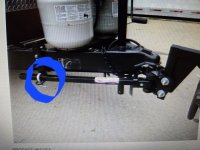- Joined
- Jul 31, 2001
- Messages
- 8,896
OK, got an F550 to haul the Bronco and tow a trailer.
Planned on running a weight distribution hitch (cause it sounds like a smart thing to do). Hauled the trlr with the truck and the wt distr. hitch easily. Used the trlr jack to raise the tongue enough to slip the trunion type (square) bars into place on their brackets. Did the same procedure with the trailer and a 3/4ton Chev. Towed well (after new tires).
Loaded the Bronco on the 550, tried to connect the wt distribution bars and after adjusting the hitch and the brackets that support the wt dist bars, it's next to impossible to raise the bars up on to the brackets on the trlr so the "weight distribution bars" will work.
I'll include a pic of the hitch and wt distr bars as it functions as an anti-sway bar also.
ANYWAY, here's the problem. With an F550 and 1,000#'s of tongue wt the truck's rear bumper settles a whopping 7/16" when the tongue sets on the ball. What this means is the truck and tongue can't move up enough to allow the bars to swing onto the brackets on the tongue. In fact, the bars only need to lift 1" up onto the brackets to fit (and work). NOTHING can lift the back of the truck with the Bronco on it enough to allow the bars to pivot/lift up onto the brackets they ride on.
When connecting this setup to a 3/4 ton truck the suspension allows about 4-5" vertically so it's easy to lift the tongue/back end of any pickup high enough so the bars will swing over and latch into place. Difference between the 2500 series and an F550 is what it is.
The second pic with the blue circle is the end of the wt distr. bar that can't be lifted up onto the bracket that is circled
Planned on running a weight distribution hitch (cause it sounds like a smart thing to do). Hauled the trlr with the truck and the wt distr. hitch easily. Used the trlr jack to raise the tongue enough to slip the trunion type (square) bars into place on their brackets. Did the same procedure with the trailer and a 3/4ton Chev. Towed well (after new tires).
Loaded the Bronco on the 550, tried to connect the wt distribution bars and after adjusting the hitch and the brackets that support the wt dist bars, it's next to impossible to raise the bars up on to the brackets on the trlr so the "weight distribution bars" will work.
I'll include a pic of the hitch and wt distr bars as it functions as an anti-sway bar also.
ANYWAY, here's the problem. With an F550 and 1,000#'s of tongue wt the truck's rear bumper settles a whopping 7/16" when the tongue sets on the ball. What this means is the truck and tongue can't move up enough to allow the bars to swing onto the brackets on the tongue. In fact, the bars only need to lift 1" up onto the brackets to fit (and work). NOTHING can lift the back of the truck with the Bronco on it enough to allow the bars to pivot/lift up onto the brackets they ride on.
When connecting this setup to a 3/4 ton truck the suspension allows about 4-5" vertically so it's easy to lift the tongue/back end of any pickup high enough so the bars will swing over and latch into place. Difference between the 2500 series and an F550 is what it is.
The second pic with the blue circle is the end of the wt distr. bar that can't be lifted up onto the bracket that is circled
Attachments
Last edited:













